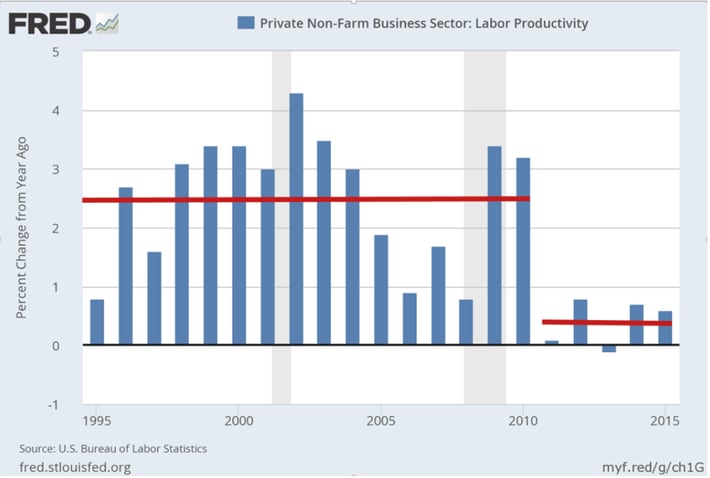
A Head Scratcher: Solving the Productivity Riddle
I came across a chart recently that left me scratching my head. It was from the Federal Reserve Bank of St. Louis, featuring U.S. Bureau of Labor Statistics (BLS) on labor productivity.

Per BLS, “Labor productivity is a measure of economic performance that compares the number of goods and services produced (output) with the number of labor hours used in producing those goods and services. Technological advances, greater investment in machinery and equipment by businesses, increases in worker skill and experience, and other improvements to production can all lead to labor productivity growth.”
The net-net is this – 1) over a 15-year period from 1995 to 2010, labor productivity growth averaged about 2.56% per year; and 2) since 2011, the annual growth rate in labor productivity has averaged .46%.
What About All of That Investment in IT?
There is a clear disconnect between what businesses are spending on technology, and how that spending translates into productivity. With total technology purchases by business and government going up by an average of 4.8%, why is productivity growth stuck at less than .5% per year?
McKinsey’s Digital America: A Tale of the Haves and the Have-Mores summarizes this paradox:
“In the late 1980s, digital adoption grew in many sectors, and productivity growth soon followed. Total productivity growth among US businesses averaged only about 0.7 percent per year between 1975 and 1995, but over the next decade, it rose to an annual average of 1.6 percent, increasing nearly 2.5 times as fast as in the preceding 20 years. These gains can be attributed at least in part to increased business investment in ICT [information and communication technology] tools, as the most digitized sectors (including the ICT sector itself) posted some of the largest productivity gains… But after 2005, these effects vanish from the measured statistics. Total productivity growth has fallen by two-thirds since 2005, while real GDP growth has averaged about 2 percent per year—all during a period in which the digital economy has continued to grow.”
The next generation of business problems require a 360-degree view of information and access to this information – both data and content, in geometrically increasing volumes, and regardless of where it is stored. According to McKinsey’s Digital America: A Tale of the Haves and the Have-Mores, “Digitization is not just about buying IT equipment and systems. The most explosive growth is now in usage as companies continue to integrate digital tools into an ever-widening variety of business processes.”
Leading edge organizations will solve it by thinking differently about the question of how information is organized and utilized.
About John Mancini
John Mancini is the President of Content Results, LLC and the Past President of AIIM. He is a well-known author, speaker, and advisor on information management, digital transformation and intelligent automation. John is a frequent keynote speaker and author of more than 30 eBooks on a variety of topics. He can be found on Twitter, LinkedIn and Facebook as jmancini77. Recent keynote topics include: The Stairway to Digital Transformation Navigating Disruptive Waters — 4 Things You Need to Know to Build Your Digital Transformation Strategy Getting Ahead of the Digital Transformation Curve Viewing Information Management Through a New Lens Digital Disruption: 6 Strategies to Avoid Being “Blockbustered” Specialties: Keynote speaker and writer on AI, RPA, intelligent Information Management, Intelligent Automation and Digital Transformation. Consensus-building with Boards to create strategic focus, action, and accountability. Extensive public speaking and public relations work Conversant and experienced in major technology issues and trends. Expert on inbound and content marketing, particularly in an association environment and on the Hubspot platform. John is a Phi Beta Kappa graduate of the College of William and Mary, and holds an M.A. in Public Policy from the Woodrow Wilson School at Princeton University.


